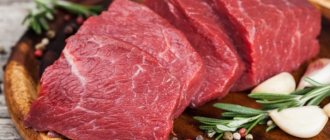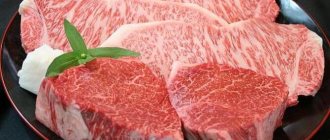Lately, red meat has gotten a bad rap because it contains higher amounts of saturated fat for our bodies than white meat.
Some nutritionists recommend not to abuse this meat and not eat it more than two or three times a week. This does not mean that we should abandon it completely.
Red meat is indeed richer in iron and some vitamins such as folic acid or vitamins B12, B1, B2 and B5. Let's look at what is considered red meat.
Today's meat is not what it used to be
Humans have eaten meat throughout evolution, and their digestive systems are well suited to it.
Traditional peoples such as the Maasai ate much more red meat than the average Westerner and remained in excellent health.
However, the meat consumed today is different from the meat people ate in the past. Once upon a time, animals roamed freely and ate grass, insects, or other foods that were natural to them.
Imagine a wild cow in a field 10,000 years ago, wandering around the field and munching on grass and other edible plants.
The meat of this animal is different from the meat that comes from a cow that was born and raised in a factory fed a grain-based diet loaded with growth-promoting hormones and antibiotics.
Today, some meat products are highly processed after slaughter. They are smoked, dried, then treated with nitrates, preservatives and various chemicals.
Therefore, it is very important to distinguish between different types of meat:
- Processed meats: These products typically come from conventionally raised cows that are then subjected to various processing methods. Examples include sausages and bacon.
- Regular Red Meat: Regular red meat is not highly processed, but the cows are usually raised in factory farms. Raw red meat is defined as red meat. This includes lamb, beef, pork and some other types of meat.
- White Meat: When cooked, white meat is defined as white meat. It includes poultry meats such as chicken and turkey.
- Organic Grass-Fed Meat: This meat comes from animals that have been fed naturally and raised organically, without drugs or hormones. They also do not contain any artificial chemicals.
When studying the health effects of meat, it is important to understand that not all meat is created equal.
Many studies of red meat, especially those conducted in the United States, primarily look at meat from factory-farmed animals fed a grain diet.
Conclusion: It is important to distinguish between different types of meat. For example, grass-fed and organic meats are nutritionally different from processed meats raised on factory farms.
Poultry: ducks and geese
Although some types of poultry, such as chicken, are considered white meat, these two types have traditionally been included in the red meat list. We are talking about two species - ducks and geese.
These two types of meat have a strong and persistent flavor and are associated with French cuisine. These benefits of duck are essential amino acids, vitamins or minerals in group B. Such as iron, zinc or phosphate.
Red meat is very nutritious
Red meat is one of the most nutritious foods you can eat.
It is rich in vitamins, minerals, antioxidants and other nutrients that can have a huge impact on health.
A 3.5 ounce (100 gram) serving of raw ground beef (10% fat) contains:
- Vitamin B3 (niacin): 25% DV.
- Vitamin B12 (cobalamin): 37% DV (this vitamin is not available in plant foods)
- Vitamin B6 (pyridoxine): 18% DV.
- Iron: 12% of the RDI (this is high-quality heme iron that is much better absorbed than iron from plants).
- Zinc: 32% DV
- Selenium: 24% DV
- Many other vitamins and minerals in smaller quantities
A serving contains 176 calories, 20 grams of quality animal protein and 10 grams of fat.
Red meat is also rich in important nutrients such as creatine and carnosine. Those who don't eat meat often have low levels of these nutrients, which can potentially affect muscle and brain function (5).
Grass-fed beef is even more nutritious than grain-fed beef, containing high levels of heart-healthy omega-3s, CLA fatty acid, and higher amounts of vitamins A and E (,,).
Bottom line: Red meat is highly nutritious, especially when it comes from animals that have been fed and raised naturally. It is an excellent source of protein, iron, B12, zinc, creatine and other nutrients.
Beef
Beef has a rich taste. Beef has several benefits. Firstly, it is very rich in protein. By consuming just 100 grams of beef per day, we are likely to get almost half of our daily protein requirement. Which our body needs.
Beef also contains B vitamins and is rich in phosphorus, a mineral that is very important for intellectual development and bone formation.
Heart disease, diabetes and death
The health effects of red meat have been well studied.
However, most of these studies are so-called observational studies, which are designed to detect associations but cannot prove causation.
Several observational studies show that red meat is associated with an increased risk of cardiovascular disease, cancer, and death ().
However, not all red meat has the same health effects.
An extensive review of 20 studies involving 1,218,380 people found that processed meat is associated with an increased risk of heart disease and diabetes. However, no association was found with unprocessed red meat ().
In the EPIC study, a very large observational study of 448,568 people, processed meat increased the risk of death, while no effect was seen for unprocessed red meat ().
When it comes to increased risk of heart disease, diabetes, and death, it's important to differentiate between processed and unprocessed meats, as they can have very different effects.
Observational studies seem to agree that processed meat (rather than unprocessed red meat) is associated with an increased risk of early death and many diseases.
But even so, it is important to remember that these studies have limitations. No firm conclusions can be drawn from observational studies.
The only way to establish cause and effect is to conduct randomized controlled trials.
Conclusion: Some observational studies show a link between meat consumption, diabetes, heart disease and death. Other studies suggest that this only applies to processed meats, not unprocessed red meats.
Why is meat a certain color?
What is red meat? Myoglobin gives it its color. It is a type of protein in the heart and skeletal muscles. Myoglobin is found in all muscles, but in different quantities. This protein is saturated with oxygen in different ways. This is what determines the specific color of the meat. Also, the color is influenced by the age of the animal and its activity (a certain load and degree of movement). For young animals, the type of food is extremely important. Often the meat of males is redder than that of females. If the animal's muscles are better developed, its meat has a richer color. Myoglobin is very low in young meat breeds.
Does red meat increase your risk of cancer?
Many observational studies show that red meat consumption is associated with an increased risk of cancer (,,).
The main type of cancer caused by red meat is colorectal cancer, the fourth most commonly diagnosed cancer in the world.
A persistent problem with these studies is that they combine processed meats with unprocessed red meats.
Meta-analyses, in which researchers analyze data from many studies, show that the increased risk of colorectal cancer is very low. One meta-analysis showed a weak effect in men but not in women (,).
Other studies suggest that it is not the meat itself, but rather harmful compounds produced when meat is cooked, that contribute to the increased risk (,).
Therefore, the way meat is prepared may be a major determinant of health.
Bottom line: Several observational studies suggest that red meat eaters are at greater risk of cancer, but larger reviews looking at the evidence as a whole so far suggest the effect is weak and inconsistent.
Summarize
- It is difficult to link one food or group of foods to health problems. This is because a number of other factors, including genetics, environment, health history, stress levels, sleep quality, lifestyle and other dietary factors, may play a role in whether a person develops a particular condition or disease.
- However, there is growing evidence that eating large amounts of red meat, especially processed meat, can lead to health problems.
- Major health organizations such as AICR and AHA suggest eating more plant-based foods and less meat to combat disease.
- For this reason, people may want to reduce their consumption of red and processed meat and focus on foods that contain antioxidants and nutrients, such as fruits and vegetables, which can help prevent health problems.
- It's important to remember that replacing red meat with low-quality processed carbohydrates can worsen insulin sensitivity, triglyceride levels, and overall health.
Source
Correlation does not equal causation
If you look closely, almost all of the studies that claim to show that red meat is harmful are observational.
These types of studies can only demonstrate a correlation, or that two variables are related.
They can tell us that people who eat a lot of red meat are more likely to get sick, but they can't prove that red meat is the cause.
One of the main problems with such studies is that they are susceptible to various confounding factors.
For example, people who eat red meat are less health conscious and are more likely to smoke, drink heavily, eat more sugar, exercise less, etc.
People who care about their health behave differently, and it is impossible to correct all these factors.
Another problem with observational studies is that they are usually based on food frequency questionnaires, which require people to remember what they ate in the past.
It's always a bad idea to base decisions about your health solely on observational studies. There are many cases in history where randomized controlled trials ended with the exact opposite effect.
For example, the Nurses' Health Study once found that estrogen replacement therapy helped reduce heart disease in women. A randomized controlled trial later found that it actually increased the risk ().
Conclusion: Observational studies cannot be used to determine cause and effect. There are many contradictions in such studies, and better studies sometimes end up with the exact opposite effect.
Mutton
This product contains a sufficient amount of valuable vitamins and microelements. It is rich in easily digestible protein, magnesium, phosphorus, potassium and iron. In addition, lamb contains a lot of calcium and fluorine, so it is advisable to give it to children. Regular consumption of this product helps increase appetite, improve food digestibility and activate the pancreas.
Those who are not aware of which red meat is healthier will be interested to know that lamb contains much less cholesterol than beef or pork. In addition, the use of this product significantly reduces the risk of developing diabetes and has a positive effect on teeth and bones. Lamb contains components necessary for hematopoiesis. And the iodine it contains helps normalize the functioning of the thyroid gland. It should definitely be on the menu of old people and children.
“What is red meat?” the reader will ask. We answer: one that contains high concentrations of myoglobulin. Like any such product, lamb has a number of contraindications. It is advisable to completely exclude it from the diet of people suffering from diseases of the gallbladder, kidneys and liver. It is also not recommended for use for gout, high acidity and stomach ulcers.
A look at some randomized controlled trials
Randomized controlled trials are the gold standard of science.
In these studies, people are randomly assigned to groups. For example, one group follows diet A and another group follows diet B.
Researchers then follow people and see which diet is more likely to lead to a particular outcome.
Few randomized controlled trials have directly examined the health effects of red meat.
Several studies have examined the effects of red meat on risk factors for heart disease.
One review of controlled studies concluded that eating half or more of a serving of red meat daily does not have a negative effect on heart disease risk factors such as blood lipids and blood pressure ().
Another review found that lean, unprocessed beef had no negative effects on people's blood lipids compared to poultry or fish ().
Red meat, being a rich source of protein, also promotes muscle growth in people doing strength training.
A study in older women found that eating 160 grams of red meat six days a week for four months improved muscle growth from strength training compared to pasta or rice ().
Red meat also reduces levels of the inflammatory marker IL-6 ().
Keep in mind that all of these studies looked at lean red meat. To date, there are no studies examining the health effects of fatty red meat.
However, there are many studies that compare high-fat diets and low-fat diets.
The main goal of these studies is to reduce saturated fat, which means that people participating in them should eat less red and processed meat, which are high in saturated fat.
The Women's Health Initiative study included more than 46,000 women. One group was advised to eat a low-fat diet, while the other group continued to eat a standard Western diet.
After 7.5 years, there was almost no difference in weight between the groups (only 1 lb/0.4 kg). There was also no difference in the incidence of heart disease or cancer (,,,).
One randomized controlled trial compared the Atkins diet (high in red meat) with the Ornish diet (a low-fat vegetarian diet without red meat). This is called the A to Z Weight Loss Study ().
After a year, the Atkins group lost more weight and improved some of the most important disease risk factors.
Many other studies have compared low-carb (high red meat) and low-fat (low red meat) diets. In these studies, low-carb diets lead to much better health outcomes (,,).
Taken together, these studies suggest that unprocessed red meat has no harmful health effects and may even have benefits.
However, more research is needed to examine whether it has an impact on hard endpoints such as heart disease and cancer. The role of preparation methods and processing technologies also requires further study.
Conclusion: Several randomized controlled trials show that consuming unprocessed red meat has no negative health effects. It may even have benefits.
Links[edit]
- "Red Meat". thefreedictionary.com.
- "White meat". thefreedictionary.com.
- ↑ Reinagel M ( 2
, 2013) "Color confusion: identifying red and white meat". Academy of Nutrition and Dietetics. Archived from the original on December 30, 2016. Retrieved April 29, 2022. - ^ ab Larousse Gastronomique, first edition
- ^ ab Johnston BC, Zeraatkar D, Han MA, Vernooij RW, Valli C, El Dib R, et al (November 2022). "Consumption of unprocessed red meat and processed meat: Dietary recommendations from the Nutrition Recommendations Consortium (NutriRECS)". Annals of Internal Medicine
.
171
(10):756–764. DOI: 10.7326/M19-1621. PMID 31569235. - ^ B s d e g h Penner KP, Clark MP (September 1990). "Red Meat: Nutrient Contributions to Diet". Iowa Livestock. Archived from the original on March 24, 2009. Retrieved September 16, 2009.
- ^ abcdef "USDA-Fresh Pork Safety...Farm to Table". Fsis.usda.gov. 2008-05-16. Archived from the original on September 18, 2013. Retrieved September 16, 2009.
- Larousse Gastronomique
, 1961,
S.
pork - Dougherty PH (15 January 1987). "ADVERTISING. Seasoning Pork for Success". New York Times
. Archived from the original on 2017-02-14. - ↑
Hall T (November 13, 1991).
"And this pig is now on the menu". New York Times
. Archived from the original on 2017-02-14. - Smil V (2002). "Meat consumption: evolution, patterns and consequences." Population and Development Review
.
28
(4):599–639. DOI: 10.1111/j.1728-4457.2002.00599.x. JSTOR 3092782. - "USDA ERS - Red Meat and Poultry Per Capita Vanishing: A Look at Its Steady Rise". www.ers.usda.gov
. Retrieved December 3, 2022. - "Red Meat: Nutrient Contributions to the Diet" (PDF). Kansas State University Agricultural Experiment Station and Cooperative Extension Service. September 1990. Archived from the original (PDF) on September 12, 2006.
- Jump up ↑
Williams PG (September 2007). "Nutritional composition of red meat". University of Wollongong. Archived from the original on 2011-03-10. - Jump up
↑ Schmid A, Walther B (July 2013).
"Natural Vitamin D Content of Animal Foods". Advances in Nutrition
.
4
(4): 453–62. DOI: 10.3945/an.113.003780. PMC 3941824. PMID 23858093. - ^ abc "Food Pyramids: What You Should Really Eat". Harvard School of Public Health. 2012. Archived from the original on 2009-04-16.
- "MyPlate Protein Products". USDA. Archived from the original on 2013-01-16.
- Rohrmann S, Overvad K, Bueno-de-Mesquita HB, Jakobsen MU, Egeberg R, Tjønneland A, et al (March 2013). "Meat consumption and mortality—results from the European Prospective Study of Cancer and Nutrition". BMC Medicine
.
11
(1): 63. DOI: 10.1186/1741-7015-11-63. PMC 3599112. PMID 23497300. The results of our analysis support a moderate positive association between processed meat consumption and mortality, particularly from cardiovascular disease and also from cancer. - "Questions and answers about the carcinogenicity of consumption of red meat and processed meat". World Health Organization. October 1, 2015. Retrieved August 7, 2022.
- ^ abc International Agency for Research on Cancer (October 26, 2015), IARC Monographs Assess Red Meat and Processed Meat Consumption (PDF), archived (PDF) from original November 10, 2015.
- Santarelli RL, Pierre F, Corpet DE (2008). "Processed meats and colorectal cancer: a review of epidemiological and experimental evidence". Nutrition and cancer
.
60
(2): 131–44. DOI: 10.1080/01635580701684872. PMC 2661797. PMID 18444144. - ^ab Chan DS, Lau R, Aune D, Vieira R, Greenwood DC, Kampman E, Norath T (06/06/2011). "Red and processed meats and colorectal cancer incidence: a meta-analysis of prospective studies". PLOS ONE
.
6
(6):e20456. Bibcode: 2011PLoSO...620456C. DOI: 10.1371/journal.pone.0020456. PMC 3108955. PMID 21674008. In nonlinear models, the risk of colorectal cancer increases almost linearly with red and processed meat consumption increasing to approximately 140 g/day. Above this level, the increase in risk is less pronounced. - ^ ab Bouvard V, Loomis D, Guyton KZ, Grosse Y, Ghissassi FE, Benbrahim-Tallaa L, et al. (December 2015). "Carcinogenicity of Red and Processed Meat Consumption" (PDF). Lancet.
Oncology .
16
(16): 1599–600. doi:10.1016/s1470-2045(15)00444-1. PMID 26514947. - ^ ab Wolk A (February 2022). "Potential Health Hazards from Eating Red Meat." Journal of Internal Medicine
.
281
(2):106–122. DOI: 10.1111/joim.12543. PMID 27597529. S2CID 24130100. - ^ab Misha R, Wallace SK, Mozaffarian D (June 2010). "Red and processed meat consumption and the risk of coronary heart disease, stroke and diabetes mellitus: a systematic review and meta-analysis". Circulation
.
121
(21):2271–83. DOI: 10.1161/CIRCULATIONAHA.109.924977. PMC 2885952. PMID 20479151. - ^ a b Leung T.H. (2012). "Red Meat Consumption: The Good and the Bad" (PDF). Noncommunicable disease surveillance
.
5
: 1–7. Archived (PDF) from the original on December 30, 2015. - Micha R, Micha G, Mozaffarian D (December 2012). "Unprocessed red and processed meats and the risk of coronary heart disease and type 2 diabetes—an updated review of the evidence". Current reports on atherosclerosis
.
14
(6): 515–24. DOI: 10.1007/s11883-012-0282-8. PMC 3483430. PMID 23001745. - Hu FB, van Dam RM, Liu S (July 2001). "Diet and the risk of type II diabetes: the role of fats and carbohydrates". Diabetology
.
44
(7): 805–17. DOI: 10.1007/s001250100547. PMID 11508264. - "Press Release: IARC Monographs Assess Red Meat and Processed Meat Consumption" (PDF). International Agency for Research on Cancer, World Health Organization. October 15, 2015. Retrieved October 26, 2015.
- "Processed meat and cancer - what you need to know". Cancer Research UK - Science Blog
. Archived from the original on January 9, 2022. Retrieved December 29, 2016. - Zhu X, Yang X, Zhang Q, Zhu Q, Tao G, Zhao L, et al (2013). "Consumption of red and processed meat is associated with a higher risk of gastric cancer: a meta-analysis of epidemiological observational studies". PLOS ONE
.
8
(8):e70955. Bibcode: 2013PLoSO...870955Z. DOI: 10.1371/journal.pone.0070955. PMC 3743884. PMID 23967140. - "Inherited bowel cancer". geneticeducation.nhs.uk
. Archived from the original on December 25, 2014. - Jeyakumar A, Dissabandara L, Gopalan V (April 2022). "A critical review of the biological and molecular characteristics of red and processed meats in colorectal carcinogenesis." Journal of Gastroenterology
.
52
(4):407–418. DOI: 10.1007/s00535-016-1294-x. PMID 27913919. S2CID 20865644. - ^ a b Kim K, Hyun J, Lee SA, Kwon SO, Lee H, Geum N, et al. (August 2022). "The role of total, red, processed and white meat in stroke morbidity and mortality: a systematic review and meta-analysis of prospective cohort studies". Journal of the American Heart Association
.
6
(9):e005983. DOI: 10.1161/jaha.117.005983. PMC 5634267. PMID 28855166. - O'Connor LE, Kim JE, Campbell WW (January 2017). "Total red meat consumption of ≥0.5 servings per day does not have a negative effect on cardiovascular disease risk factors: a systematically searched meta-analysis of randomized controlled trials". American Journal of Clinical Nutrition
.
105
(1):57–69. DOI: 10.3945/ajcn.116.142521. PMC 5183733. PMID 27881394. - ↑
Pan A, Sun Q, Bernstein AM, Schulze MB, Manson JE, Willett WC, Hu FB (October 2011).
"Red meat consumption and risk of type 2 diabetes: 3 groups of US adults and an updated meta-analysis". American Journal of Clinical Nutrition
.
94
(4):1088–96. DOI: 10.3945/ajcn.111.018978. PMC 3173026. PMID 21831992. - Fretts AM, Follis JL, Nettleton JA, Lemaitre RN, Ngwa JS, Wojczynski MK, et al (November 2015). "Meat consumption is associated with higher fasting glucose and insulin concentrations, independent of genetic risk scores for glucose and insulin: a meta-analysis of 50,345 Caucasians". American Journal of Clinical Nutrition
.
102
(5):1266–78. DOI: 10.3945/ajcn.114.101238. PMC 4625584. PMID 26354543. - Schwingshackl L, Hoffmann G, Lampousi AM, Knüppel S, Iqbal K, Schwedhelm C, et al (May 2017). "Dietary groups and risk of type 2 diabetes mellitus: a systematic review and meta-analysis of prospective studies". European Journal of Epidemiology
.
32
(5): 363–375. DOI: 10.1007/s10654-017-0246-у. PMC 5506108. PMID 28397016. - "Chemicals in meat cooked at high temperatures and cancer risk". National Cancer Institute
. 2022. Archived 11/06/2011. - "Marinades reduce heterocyclic amines from primitive cooking methods". Schor J. Archived December 25, 2014.
- "Seer Statistics Fact Sheets: Colon and Rectal Cancer". Seer.cancer.gov
. National Cancer Institute. Archived June 24, 2014.
Optimizing the preparation of red meat
When meat is cooked at high temperatures, it can form harmful compounds.
These include heterocyclic amines (HAs), polycyclic aromatic hydrocarbons (PAHs) and advanced glycation end products (AGEs).
These substances can cause cancer in animals. If meat does increase the risk of cancer (which has yet to be proven), this could be the reason (,,).
But it's not just meat; other foods can also form harmful compounds when overheated.
Here are some tips to help prevent the formation of these harmful substances in meat:
- Use gentler cooking methods such as sautéing and steaming instead of grilling and frying.
- Minimize high-heat cooking and never expose meat to fire.
- Do not eat charred and/or smoked foods. If your meat is burnt, trim off the charred bits.
- If you marinate meat in garlic, red wine, lemon juice or olive oil, this can significantly reduce your BG levels.
- If you must cook over high heat, turn the meat frequently to prevent it from burning.
Many people like the taste of fried meat. But if you want to enjoy meat and get all the benefits without any of the potentially harmful consequences, use gentler cooking methods and avoid burnt meat.
Bottom line: To prevent the formation of harmful substances when cooking meat, choose gentler cooking methods and avoid burning the meat.
Admission Tips
There are several rules for healthy meat consumption:
- Using gentle cooking methods. Preference should be given to stewing, boiling, steaming or baking in the oven. Eating fried red meat should be limited or avoided altogether.
- Refusal of vegetable oils. If it is impossible to refuse fried meat, you should limit the use of vegetable oils, which, after thermal exposure, negatively affect the incidence of cancer. It is recommended to give preference to pans with a non-stick coating.
- Combination with vegetables and fruits. Any plant-based dishes reduce the carcinogenic properties of meat products. The most valuable in this regard are representatives of the Cruciferous family (cabbage, broccoli, arugula, spinach, turnips, kohlrabi).
- Avoid processed meats. Sausages, sausages, marinated, dried, smoked meat do not bring significant benefits to the body, but on the contrary, have a negative effect, as they contain a lot of fats, flavors and other additives. The concentration of essential vitamins is extremely low.
- Rationing of admission. Such meat is rich in fats, which, if taken uncontrolled, significantly increase the energy value of the diet and increase the risk of obesity.
- Pair with some drinks. It has been proven that eating meat with coffee or red wine significantly reduces the carcinogenic effect.
- Manufacturer's choice. It should be remembered that any animals on farms require careful monitoring, otherwise they can serve as sources of parasites. It is also recommended to give preference to meat from animals that were not raised with antibacterial and hormonal drugs.
Following simple rules of consumption and selection can significantly reduce the negative properties of meat.
What are the benefits of white meat?
Compared to red meat, white meat has much less protein, but its calorie content is significantly lower . That is why these products are used for dietary nutrition. White meat is a source of essential unsaturated acids. And although it contains much less protein, meat is considered very healthy. It is ideal for those who want to lose extra pounds and lower cholesterol. By reducing “bad” cholesterol, we enable blood vessels to be elastic, and reduce the risk of strokes and cerebral atherosclerosis. A balanced diet is the basis of a healthy lifestyle.
Unique meat vitamins, minerals and amino acids
The defendant Diet B.M. (Without Meat) is accused of lacking vitamin B12, iron and amino acids necessary for the body, as well as misleading gullible citizens of the Russian Federation. Stop! This is some kind of fabricated case!
Meat does not carry unique vitamins, minerals and amino acids. These substances are found in various foods. Let's not go far, let's go to the first library site of food profiles we come across and take a look.
Vitamin B12 and iron content in foods. According to the site: fitaudit.ru
Vitamin B12. Yes, it is often found in meat, especially in offal, but, in addition, there is a lot of it in fish and other seafood.
iron in all kinds of spices and herbs. On the first lines are thyme and basil.
And the 8 essential amino acids can be obtained from different foods. The main thing is not to eat the same thing every day. In a previous article, I talked about regular and gluten-free pasta. Even they have all the necessary amino acids in their composition.
Content of essential amino acids in regular and gluten-free pasta. Author: Roman Gorshkov @romancaravan
Conclusion on unique nutrients in meat
It does not contain any substances unique to meat (vitamins, minerals and amino acids) known to science. Miss.
Meat biathlon: miss target number 4. Author: Roman Gorshkov @romancaravan
Dietary animal meat
The number of animals whose meat is recognized as dietary includes:
- beef, mainly tenderloin or thin cut. It is not recommended to take a thigh lift, as it is very difficult and takes a long time to digest;
- horse meat - has a specific flavor to its taste. However, it is also dietary;
- veal - younger beef, which has not yet managed to gain much fat, but is easily digestible;
- Rabbit meat is one of the best and healthiest types of meat. The usefulness of rabbit meat has been recognized by pediatricians and is recommended for feeding even small children.
Heaviness in the stomach due to meat
Meat has the reputation of being heavy food, after which it is difficult to think and you want to lie down. There are even more terrible statements. For example, that meat rots in the intestines. But what if I told you that all this is not entirely true and in fact, regarding the stomach and intestines, it is worth paying attention to other things. Let's figure it out.
Photo: Ava Sol
About food culture
Firstly, the heaviness after meat is primarily influenced by the culture of its consumption. What do restaurants serve steaks with? With potatoes and rich sauces. Often, steak is washed down with beer or other alcohol. Or remember the burger. This is white bread, cucumbers, cheese, bacon, tomatoes, mayonnaise, ketchup - an incredibly heavy set of various ingredients.
In contrast, let's take the culture of eating, for example, salmon. Yes, of course, this fish is fried and served with potatoes, but, along with this, simple baking in the oven also takes place. I'm not talking about chickpeas, which are usually eaten with vegetables.
In general, conduct an experiment for yourself. Try to eat meat in a controlled manner. For example, bake it in optimal quantities with broccoli without sauces.
About genetics
Secondly, I am convinced that genetics have a big influence. The fact is that the diets of different cultures vary greatly. If your ancestors are used to being nimble and hungry, most likely your body will not respond well to large amounts of heavy meat food. If your ancestors are from the Caucasus... most likely, he will be more friendly to meat.
About rotting meat in the intestines
Thirdly, putrefaction is the popular name for “fermentation,” and fermentation, in another way, can be called “splitting and assimilation.” Meat, like any other food, is fermented, that is, it is broken down into its constituent elements and absorbed by the cells of the body. This is not the rotting that occurs with flies.
About Short Chain Fatty Acids (SCFAs)
However, meat can mess up your intestines! Let's take a look at this scientific paper and pull out an interesting image:
Taken from a scientific article: https://www.ncbi.nlm.nih.gov/pmc/articles/PMC5385025/ - Authors: Rasnik K. Singh and 11 others
Here are the findings of a study on the effects of plant and animal protein on the human intestine. We will skip the second column. It shows the activity of microorganisms in the intestines depending on the type of protein. Then we will meet the already familiar TMAO, the amount of which increases with a meat-containing diet. But what are SCFA's?
SCFA's = Short Chain Fatty Acids = short chain fatty acids. Incredibly important substances for the intestines. Their number increases when taking vegetable protein and decreases when taking meat. This occurs due to the activity of certain microorganisms in the intestines.
Short-chain fatty acids (SCFA's):
- are the main source of energy for intestinal cells;
- have anti-cancer and anti-inflammatory effects;
- stop the division of cancer cells and promote the process of their destruction;
- activate the process of angiogenesis, when your tissues regenerate and new blood vessels form in them.
Reducing the amount of short-chain fatty acids in the intestines increases the risk of inflammatory processes. And here it must be said that inflammatory diseases are not a binary story (yes or not), but a smooth one. At first, they may not be severe in nature, nevertheless present, but over time they develop into a disease. Need I say that inflammatory processes can contribute to a feeling of heaviness and a deterioration in general condition?
Conclusion about heaviness in the stomach due to meat
Given the culture of consumption, my own beliefs about genetics, and the negative effect of meat on the amount of short-chain fatty acids, I think it is reasonable to recognize meat as a food that can indeed cause heaviness in the stomach. Hit.
Meat biathlon: hitting target No. 5. Author: Roman Gorshkov @romancaravan











